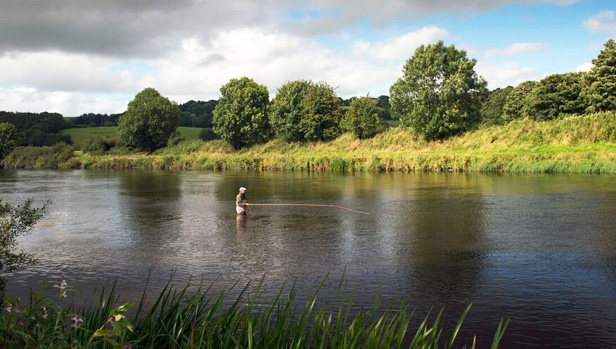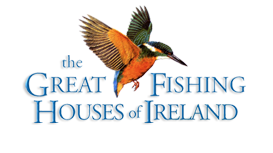

The Rivers
Ballynahinch Owenmore River
Season
Salmon: 1 February to 30 September
Sea-trout: 1 February to 12 October
Permission
There are eight separate fisheries on the Ballynahinch system. A number of them are private and I shall deal only with those that are available for letting to the general public.
The Ballynahinch system is strung like a necklace around The Twelve Bens in the heart of Connemara. Benlettery, Bengower and Bencorr patiently look down on the angler as he drifts the loughs and walks the river banks on this, one of the most beautiful and prolific fisheries in the west of Ireland.
The system is 15 miles long and from the top of the Inagh valley to the north and Lough Oorid near Maam Cross to the east it drains a catchement of 68 square miles. It once formed part of the sporting estate of the Martin family, one of whose better known members, 'Humanity Dick' Martin MP, is commemorated by a plaque at Ballynahinch Castle. In this century it was owned for a time by His Highness, The Maharaja Jorn Sahib of Nawanagar, better known on the cricket field as Ranjitsinhji. Ranji spared no expense in developing the fishery by building footbridges and weirs and a feature of the work was the construction of stone-built casting piers which still stand all along the fishery.
Ballynahinch Castle Fishery
The Ballynahinch Castle Hotel fishery consists of 2.5 miles of river, Ballynahinch Lake Lower and a narrow neck at the top of the lough known as Sna Beg, which is developed as a salmon throw. The fishery is at the bottom of a system, stretching upstream from Toombeola Bridge. This makes it a most prolific fishery since all the salmon and sea-trout coming in from the sea must pass through the fishery. It also has its own spawning beds right under the hotel.
The fishery is divided into eight salmon beats plus four sea-trout pools. It is let by the beat, which is rotated daily, and the tenant of the beat for the day may take one guest. Gillies are available on request from the fishery manager, Michael Conneely, himself one of the finest fishermen it has been my privilege to meet.
The first spring salmon run through in February and March and fish begin resting in the Ballynahinch pools in April. A number of spring fish are taken every year in April and May but the river is not heavily fished at this time. There is a belief among fishery staff in the area that the early season run may be greater than is suspected. A lot of big fish, 10 lb - 12 lb and some well over 20 lb turn up on the redds every autumn and these have obviously been in the system from early spring.
It is the big grilse run that draws the anglers to Ballynahinch. It begins in late May or early June and peaks in late June and early July. It is these fish, with a small injection of September-run fish, that provide the best of the salmon fishing at Ballynahinch. The hours of fishing are from 10 am to 7 pm and from 8.30 pm to dusk, a custom based on the belief that salmon pools should be well rested. Fly-fishing is the rule but a shrimp or worm may be used between 5 and 7 pm by persons who have not caught a fish on fly before 5 pm. Spinning is allowed only in high water.
The Ballynahinch Fishery is characterized by short streams and big, deep pools. In character, it is far removed from the perceived image of a classic salmon river with its long streams and glides. However, for the angler who knows his fishing, it can be just as productive.
The streams are fished with the fly in the usual manner, casting across and allowing the fly to fish round in the current. In the slow water, movement must be imparted to the fly by retrieving line.
A small double-handed rod is useful on the river and a single-handed rod is essential. It can double up for the sea-trout fishing as well.
The popular fly patterns on the river are Ballynahinch Badger, Silver Badger, Silver Doctor, Blue Charm, Hairy Mary, Stoat's Tail, Silver Stoat, Silver Rat, Silver Grey, and Shrimp Fly.
Sea-trout
The sea-trout fishing at Ballynahinch has to be as good as an angler could hope to experience anywhere.
The first fish begin running in late June, and July and August see the best of the night fishing.
The season for daytime sea-trout fishing is from July to October. Sea-trout take well here, even in daylight conditions. Tactics are important and a single size 12 or 14 fly on floating line and fine leader gets best results. Favourite patterns are Duckfly, Connemara Black, Bibio or Watson's Fancy. A dry fly can also work by day - try a Grey Duster, a Black Gnat, a small Brown Sedge or a Daddy.
The hours for night fishing are from dusk to 12.30 am. A floating line and size 10 or 12 Silver Doctor, Bloody Butcher or Delphi Silver are the best choice. Fish only two flies on the leader. A good day or evening's fishing can produce up to a dozen trout to 5 lb - the average is about 1 lb - and with a good run of sea-trout on the river the annual catch must number nearly 3,000 trout. No one has ever counted or kept an accurate record of just how many are taken.
Excerpts taken from "Trout & Salmon Rivers of Ireland, an angler's guide" by Peter O'Reilly.

